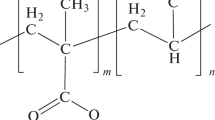Abstract
In this work, the corrosion degradation of tinplate in contact with salty water is investigated by scanning electrochemical microscopy (SECM) electrochemical impedance spectroscopy (EIS). Experimental results indicate tin maintains at passive state during the exposure; however, pores and defects existed in tin coating leads to an exposure of carbon steel substrate to the electrolyte, in which localized corrosion tends to occur within the pore. A phenomenological model is proposed to interpret corrosion mechanism of tinplate in contact with salty food based on the proposed electrochemical equivalent circuit.
Similar content being viewed by others
References
Herting, G., Odnevall Wallinder, I., and Leygraf, C., Corrosion-induced release of chromium and iron from ferritic stainless steel grade AISI 430 in simulated food contact, J. Food Eng., 2008, vol. 87, pp. 291–300.
Waters, B.W., Tatum, J.M., and Hung, Y.-C., Effect of chlorine-based sanitizers properties on corrosion of metals commonly found in food processing environment, J. Food Eng., 2014, vol. 121, pp. 159–165.
Xia, D.H. et al., Fast evaluation of degradation degree of organic coatings by analyzing electrochemical impedance spectroscopy data, Trans. Tianjin Univ., 2012, vol. 18, pp. 15–20.
Xia, D.H. et al., Corrosion behavior of novolac epoxy coated tinplate in energy drink, J. Tianjin Univ., 2012, vol. 46, pp. 503–509.
Xia, D.H. et al., Corrosion behavior of tinplate in NaCl solution, Trans. Nonferrous Met. Soc. China, 2012, vol. 22, pp. 717–724.
Chiavari, C. et al., Influence of low-temperature carburising on metal release from AISI316L austenitic stainless steel in acetic acid, J. Food Eng., 2014, vol. 137, pp. 7–15.
Martins, J.I., Corrosion problems in tinplate cans for storing contact glues for shoes, Eng. Failure Analysis, 2012, vol. 26, pp. 258–265.
Huang, X.-q. et al., Effects of reflowing temperature and time on alloy layer of tinplate and its electrochemical behavior in 3.5% NaCl solution, Trans. Nonferrous Met. Soc. China, 2014, vol. 24, pp. 1978–1988.
Blunden, S. and Wallace, T., Tin in canned food: a review and understanding of occurrence and effect, Food Chem. Toxicol., 2003, vol. 41, pp. 1651–1662.
Boogaard, P.J. et al., Comparative assessment of gastrointestinal irritant potency in man of tin(II) chloride and tin migrated from packaging, Food Chem. Toxicol., 2003, vol. 41, pp. 1663–1670.
Pournaras, A.V. et al., Evaluation of lacquered tinplated cans containing octopus in brine by employing X-ray microanalysis and electrochemical impedance spectroscopy, J. Food Eng., 2008, vol. 86, pp. 460–464.
Esteves, L. et al., Electrochemical study of corrosion in aluminium cans in contact with soft drinks, Corros. Eng., Sci. Technol., 2014, vol. 49, pp. 665–668.
Xia, D. et al., Detection of corrosion-induced metal release from tinplate cans using a novel electrochemical sensor and inductively coupled plasma mass spectrometer, J. Food Eng., 2012, vol. 113, pp. 11–18.
Zheng, X. et al., Detection of the corrosion degree of beverage cans using a novel electrochemical sensor, Anti-Corros. Methods Mater., 2013, vol. 60, pp. 153–159.
Xia, D.H. et al., A novel electrochemical noise sensor applied to detect food safety, Russ. J. Electrochem., 2014, vol. 50, pp. 599–602.
Xia, D.H., Song, S.Z., and Behnamian, Y., Detection of corrosion degradation using electrochemical noise (EN): Review of signal processing methods for identifying corrosion forms, Corros. Eng., Sci. Technol., 2016, vol. 51, pp. 527–544.
Wei, Y.-J., Xia, D.-H., and Song, S.-Z., Detection of SCC of 304 NG stainless steel in an acidic NaCl solution using electrochemical noise based on chaos and wavelet analysis, Russ. J. Electrochem., 2016, vol. 52, pp. 560–575.
Sánchez, M. et al., Assessment of the electrochemical microcell geometry by local electrochemical impedance spectroscopy of copper corrosion, Electrochim. Acta, 2012, vol. 62, pp. 276–281.
Xia, D.-H. et al., Understanding the interaction of thiosulfate with Alloy 800 in aqueous chloride solutions using SECM, J. Electroanal. Chem., 2015, vol. 744, pp. 77–84.
Xia, D.-H. et al., Semiconductivity conversion of passive films on Alloy 800 in chloride solutions containing various concentrations of thiosulfate, J. Electrochem. Soc., 2015, vol. 162, pp. C482–C486.
Zhu, R.K. and Luo, J.L., Investigation of stressenhanced surface reactivity on Alloy 800 using scanning electrochemical microscopy, Electrochem. Commun., 2010, vol. 12, pp. 1752–1755.
Xia, D.H. et al., Hydrogen-enhanced surface reactivity of X80 pipeline steel observed by scanning electrochemical microscopy, Electrochemistry, 2016, vol. 84, pp. 238–242.
Song, S., Research Technology of Corosion Electrochemical, Beijing: Chemical Industry Press, 1988, p. 16.
Reddy, B., Breakdown of organic coatings in corrosive environments examined by scanning kelvin probe and scanning acoustic microscopy, Electrochim. Acta, 2004, vol. 49, pp. 2965–2972.
Ma, Y.T., Li, Y., and Wang, F.H., Corrosion of low carbon steel in atmospheric environments of different chloride content, Corros. Sci., 2009, vol. 51, pp. 997–1006.
Xiao, K. et al., Corrosion products and formation mechanism during initial stage of atmospheric corrosion of carbon steel, J. Iron Steel Res. Int., 2008, vol. 15, pp. 42–48.
George, K.S. and Nesic, S., Investigation of carbon dioxide corrosion of mild steel in the presence of acetic acid, Part 1: Basic mechanisms, Corrosion, 2007, vol. 63, pp. 178–186.
Perez, F.R. et al., Effects of chloride concentration, immersion time and steel composition on the spinel phase formation, Mater. Chem. Phys., 2009, vol. 117, pp. 214–223.
El-Mahdy, G.A., Nishikata, A., and Tsuru, T., Electrochemical corrosion monitoring of galvanized steel under cyclic wet-dry conditions, Corros. Sci., 2000, vol. 42, pp. 183–194.
Author information
Authors and Affiliations
Corresponding author
Additional information
The article is published in the original.
Rights and permissions
About this article
Cite this article
Ma, C., Zhou, B., Xia, DH. et al. In-situ Study the Corrosion Degradation Mechanism of Tinplate in Salty Water by Scanning Electrochemical Microscopy. Russ J Electrochem 54, 216–223 (2018). https://doi.org/10.1134/S1023193517120060
Received:
Accepted:
Published:
Issue Date:
DOI: https://doi.org/10.1134/S1023193517120060




